Xwarinên Cizîrê xwedî mîraseyekî dewlemend in
Xwarinên Cizîrê xwedî mîraseyekî dewlemend in, xwebexş û kordînatorên (Mala Cizîrê) heftiya xwe ya xwarinên gelêrî bi xelekek weşana zindî li salona Xeymê ya bajarê ku bi rengrengiya çandî tê naskirin Ti Temir bi dawî kirin.
Weşana zindî bi amedebûna jimarek ji pêjerên kurd, ereb, suryan û êzîdî yên ku bi hev re xwarina (Şamborek) ya bi erebî (Sembosek) amade kirin, şamborek yek ji xwarinên hevbeş ê pêkhateyê cizîrê ye, her wiha hin stranên folklorî bi zimanê Erebî, Kurdî û Suryanî hatin pêşkêş kirin.
Heftiya xwarinên gelêrî yek ji heftiyên giring e, di projeya mala cizîrê de, ji ber xwarin beşkî giring di çand û kevneşopiyên gelê cizîrê de digire, amadekirin xwarinên wek şahiyek civakî di boneya de tê pîroz kirin.
Çalakiyan bi serdana mala dayika Enwer li bajarê Amûdê dest pê kirin, dayika Enwer hin sirên amdekirina kutilka bi erebî (Kibeb) bi suryanî (ܟܘܬܠܐ) ji xwebexş û kordînartoran re eşker kir.
Dayika Enwer got: me ev mîrase ji dayikên xwe girt wan jî ji bapîrên me girtibûn, ev xwarin wek xwarinek bingehîn li piraniya malên Cizîrê tê pêşkêşkirin, çima na ger ev yek ji xwarinên folklorî yê gelê kurd e.
(Kutilk) carna bi zeytê tên qelandin û carna bi avê tên kelandin, ev xwarin bi taybet di demsala çile de tê çêkirin, gelek caran qedehek çiqilmast an şorbe nîsk pê re tê pêşkêşkirin.
Piştî wê xwebexş û kordînatoran berê xwe dane gundê (Rotan) yê girêdayî Tirbespiyê û bûn mêvanên dayika Imad û xwarina qelyê ji wan re amdekir, qelyê yek ji xwarinên herî navdar di xwaringeha Suryanî de ye.
Li gor dayika Imad qelyê ji goştê golikan pêk tê, her wiha donê golik yê bi Teref tê naskirin, herdu tevlî hev dibin û bi hinek xwê li ser agir çend seatan tê kelandin ta ku çêdibe û bi birincê re tê pêşkêş kirin.
Berî ku herin gundê (Rotan) berê xwe dane gundê (Nihab Şerqî) li gundewarên Hesekê, li wir xwebexş tevlî amedekirina xwarinên folklorî yê gelê Erebî ya bi navê (Sirûd) tê naskirin bi kurdî (Hemîs) bi suryanî (ܚܡܝܣ) bûn.
Sirûd yek ji xwarinên herî kevn e û ta niha di gelek şahiyê wek dawet, sinetkirin û ezayan tê pêşkêşkirin
Berî ku xwebexş û kordînator heftiya xwe bi dawî bikin serdana gundê Enteriyê yê Hesekê kirin, li gel Mehmûd Elmemî (mehîr) amdekirin ya bi erebî bi (Hebiya) û bi suryanî (ܠܒܢܝܐ) tê naskirin.
Destpêkê genim ji qirêjê tê paqijkirin û piştî wê tevlî avê dibe û piştî wê dikev conî de bi Erebî (Cirne) û bi darê conî bi Erebî (Elmedq) tê hervandin, di dawî de bi avê re tê kelandin û mast tevlî dibe ta dicemide.
Xwarin û rêbazê amedekirina xwarinê beşekî giring di çand û kevneşopiyên gelê Cizîrê (kurd, Ereb, suryan, Êzîdî) digire. Ji ber piraniya caran wek kevneşopiyekê di şahiyên civakî tê pîrozkirin û beşek ji folklore çandî yê berî sedê sala ye.
Ji ber ku xwarinên folklorî beşkî bingehîn di dîroka civaka ya nûjen de digirin, ew li kêleka mîrasa çand, mûzîk, siyasî, wêje û civakî hevrêziyek nûjen diafirîne ku bi rêya wê civak ji hev tên naskirin, her wiha yek ji amûrên herî bibandor di nav şînwara de ye.
Projeya (Mala Cizîrê) ya ku rêxistina Gav di destpêka tebaxê de dest pê kiribû, hewldanek ji bo cewziya çandî pîroz bike û pêş bixe ji ber wek cewher ji avakirin û parastina aşîtiya navxweyî û jiyan hevbeş ya domdar e, her wiha girêdane civakê xurt bike di rêya naskirin pêkhateya ji hev re û vekirin rêyên ne kilasîkî di nav wan de.
English
The al-Jazira’s delicious dishes … a rich legacy of tradition and heritage
After a week of visits to a number of villages in different regions, the team of the volunteers and coordinators of the (Bayt al-Jazira – Mala Cizîrê – ܒܝܬܐ ܕܓܖܪܬܐ) project concluded the Week of Popular Food and Dishes by organizing a live broadcast in the al-Khayma Hall in the town of Tal Tamr, which is known for its ethnic and cultural diversity.
The weekly live broadcast was completed with the participation of several Arab, Kurd, Yazidi, and Syriac cooks who collaborated in preparing the Samosa Dish (Şamborek in Kurdish and ܫܡܒܘܪܓ in Syriac), which is one the most important common dishes for the population of al-Jazira. This was done in conjunction with the presentation of a number of folk songs in Arabic, Kurdish and Syriac.
The Week of Popular Food and Dishes is one of the most important activities of the (Bayt al-Jazira – Mala Cizîrê – ܒܝܬܐ ܕܓܖܪܬܐ) project, as food is an important part of the culture and traditions of the residents of the region, and the rituals of preparing meal are considered a social celebration on various occasions.
The activities started with a visit to the town of Amuda, where Umm Anwar shared the secrets of preparing Kibbeh (Kutilk in Kurdish and ܟܘܬܠܐ in Syriac) with volunteers and coordinators.
“This dish was inherited from our mothers and grandmothers, and it is served as an entrée in most Kurdish houses. It is one of the distinguished ancient folkloric dishes for the Kurds as a whole,” Um Anwar said.
(Kutilk) pieces are served either boiled or fried. It is one of the indispensable dishes, especially in winter, and it is usually served with a glass of yogurt or lentil soup.
The team of the volunteers and coordinators visited Umm Imad in the village of Rotan in the countryside of (Al-Qahtaniyah/ تربى سبيه/ܩܒܕܐ ܚܝܘܪܐ) who participated with them in preparing the (al-Qaliya) dish, which is considered one of the most famous dishes of the Syriac cuisine.
The (al-Qaliya) dish consists of veal and calf fat, locally known as the limb. Then, it is mixed with salt and is put on the fire for hours until it is ready, to be served with rice, according to Umm Imad.
The visit to Rotan was preceded by a visit to the village of Nahhab Sharqi in the countryside of al-Hasakah, where the volunteers participated in preparing the most famous traditional Arab food, which is called Thareed or Tharoud (Hemîs in Kurdish and ܚܡܝܣ in Syriac).
Thareed is considered one of the main traditional dishes that is still present on dining tables in various regions of al-Jazira, as it is served on many occasions, such as weddings, children circumcision, and funeral ceremonies.
Before the conclusion of the Week of Popular Food and Dishes, the team of the volunteers and coordinators visited Mahmoud al-Ma’ami in the village of al-Antariyya in countryside of al-Hasakah, to prepare what is known in Kurdish as the (Mehîr) dish (Habiyya in Arabic and ܠܒܢܝܐ in Syriac).
The recipe is prepared first by cleaning and sifting wheat grains, and then soaking it with water to be placed within a trough (al-Jorn in Arabic and Conî in Kurdish) in order to be milled well with another tool called pestle (al-Middaq in Arabic and Conî in Kurdish), and then it is put with water on a low heat to be cooked well. After that, it is mixed with yogurt and left to cool.
Food preparation and its rituals occupy an important part in the culture and traditions of al-Jazira’s residents, including the Kurds, Arabs, Syriacs, and Yazidis. It is often considered a ritual of various social occasions and part of the cultural heritage accumulated for hundreds of years.
As traditional dishes are an integral part of the civilizational history of the societies, they form – in addition to the cultural, musical, literary, political and social heritage – a civilized pattern that distinguishes societies from each other. Traditional dishes are one of the most important tools of mutual influence among the population.
The (Bayt al-Jazira -Mala Cizîrê – ܒܝܬܐ ܕܓܖܪܬܐ) project launched by the (GAV) organization at the beginning of last August, is an attempt to celebrate and promote cultural differences as a fundamental pillar in building and preserving civil peace and sustainable coexistence, and enhancing societal cohesion factors through deepening knowledge of the communities with each other and opening unconventional channels of communication among them.
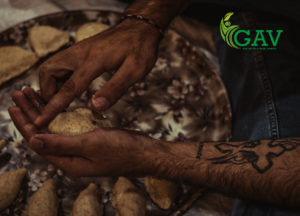 إ
إ
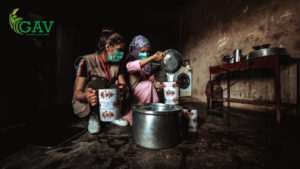
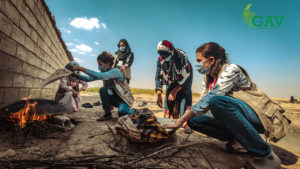
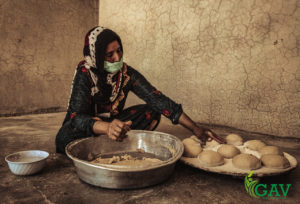
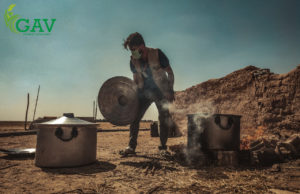 ع
ع
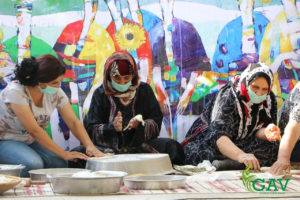 داد
داد

